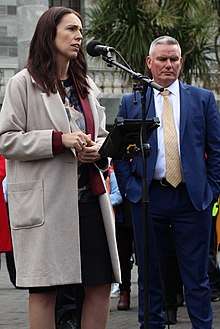New Zealand Educational Institute
| Full name | New Zealand Educational Institute Te Riu Roa |
|---|---|
| Native name | Te Riu Roa |
| Founded | 1883 |
| Members | 50,000 |
| Affiliation | Education International |
| Key people |
Lynda Stuart, President Paul Goulter, National Secretary |
| Office location | Wellington, New Zealand |
| Country | New Zealand |
| Website |
www |
.jpg)
The New Zealand Educational Institute (NZEI, in Maori: Te Riu Roa) is the largest education trade union in New Zealand. It was founded in 1883 and has a membership of 50,000.[1]
History
The NZEI was founded by a merger of district institutes of teachers in 1883[2] at a meeting in Christchurch. It quickly became the nationwide voice of primary school teachers. Since the 1994 merger with the Combined Early Childhood Union of Aotearoa (CECUA) it has also represented teachers in early childhood centres. Since the major New Zealand employment law changes in the 1980s and 1990s,[3] the NZEI negotiates the more than twenty collective agreements across the two sectors, including principals, teachers, support staff, te reo Maori immersion staff and Ministerial staff.[4]
Early childhood education
Due to the relatively fragmented history and nature of early childhood education in New Zealand, the largest number of collective agreements negotiated by the NZEI are in this sector.[4]
Primary schools
Primary staff and principals are on separate collective agreements, with separate agreements for area (rural) staff and principals, but these are negotiated together.[4]
Strikes

The NZEI has struck four times since it was founded in 1883.[5]

In 1991 members struck (unsuccessfully) as part of wider industrial and union action against the Employment Contracts Act 1991,[5] which lead to significant changes in New Zealand employment relations.[6]
Members struck in 1994 and 1995 to successfully achieve pay parity with the Post Primary Teachers' Association,[5] their colleagues in secondary schooling. This related pay scales to the teachers' qualifications.[7]
Members struck in 2018 as part of the negotiation round with the Sixth Labour Government of New Zealand. Rallies and marches were held in the major cities.[5]
References
- ↑ http://www.nzei.org.nz/NZEI/Aboutus/NZEI/About-Us/Aboutus.aspx
- ↑ "Teachers' Organisations — Primary". An Encyclopaedia of New Zealand. 1966. Retrieved 19 August 2018.
- ↑ Olssen, Erik (11 March 2010). "Unions and employee organisations - Unions after 1960". Te Ara – the Encyclopedia of New Zealand. Retrieved 19 August 2018.
- 1 2 3 https://nzei.org.nz/NZEI/Aboutus.aspx?About_Us=3
- 1 2 3 4 "Teachers' strike today: School's out - All you need to know". The New Zealand Herald. 15 August 2018. Retrieved 19 August 2018.
- ↑ https://teara.govt.nz/en/strikes-and-labour-disputes/page-10
- ↑ https://www.nzherald.co.nz/nz/news/article.cfm?c_id=1&objectid=2350693
Further reading
External links
| Wikimedia Commons has media related to New Zealand Educational Institute. |